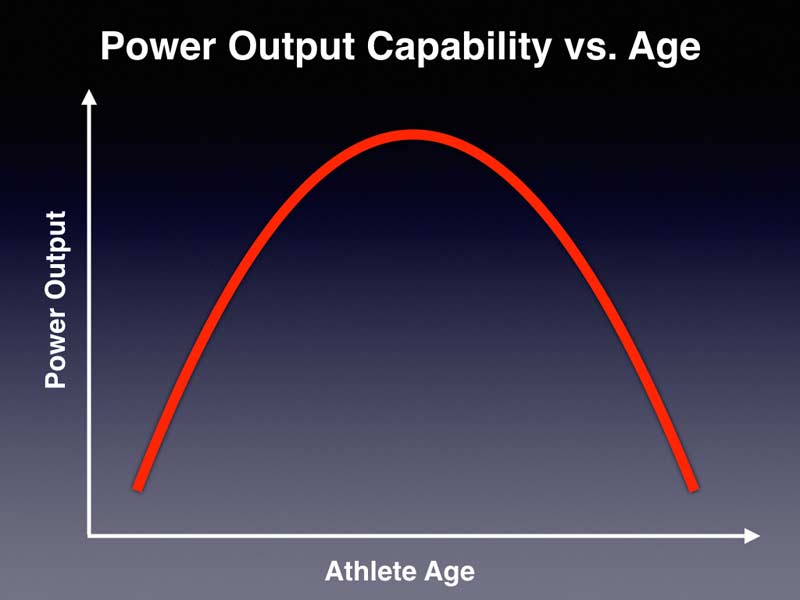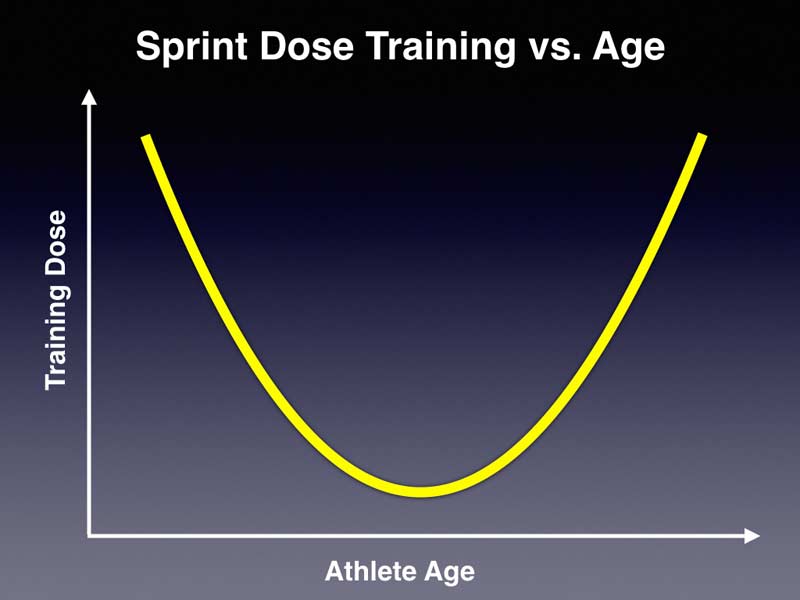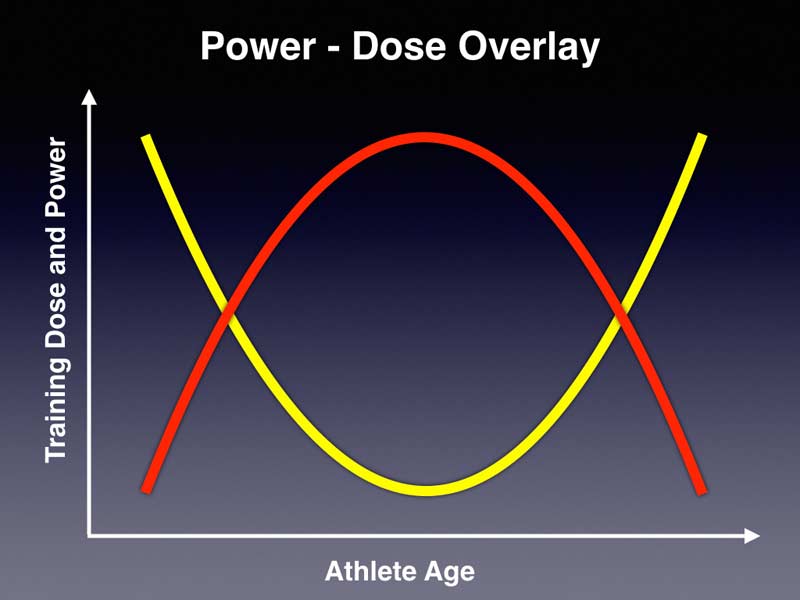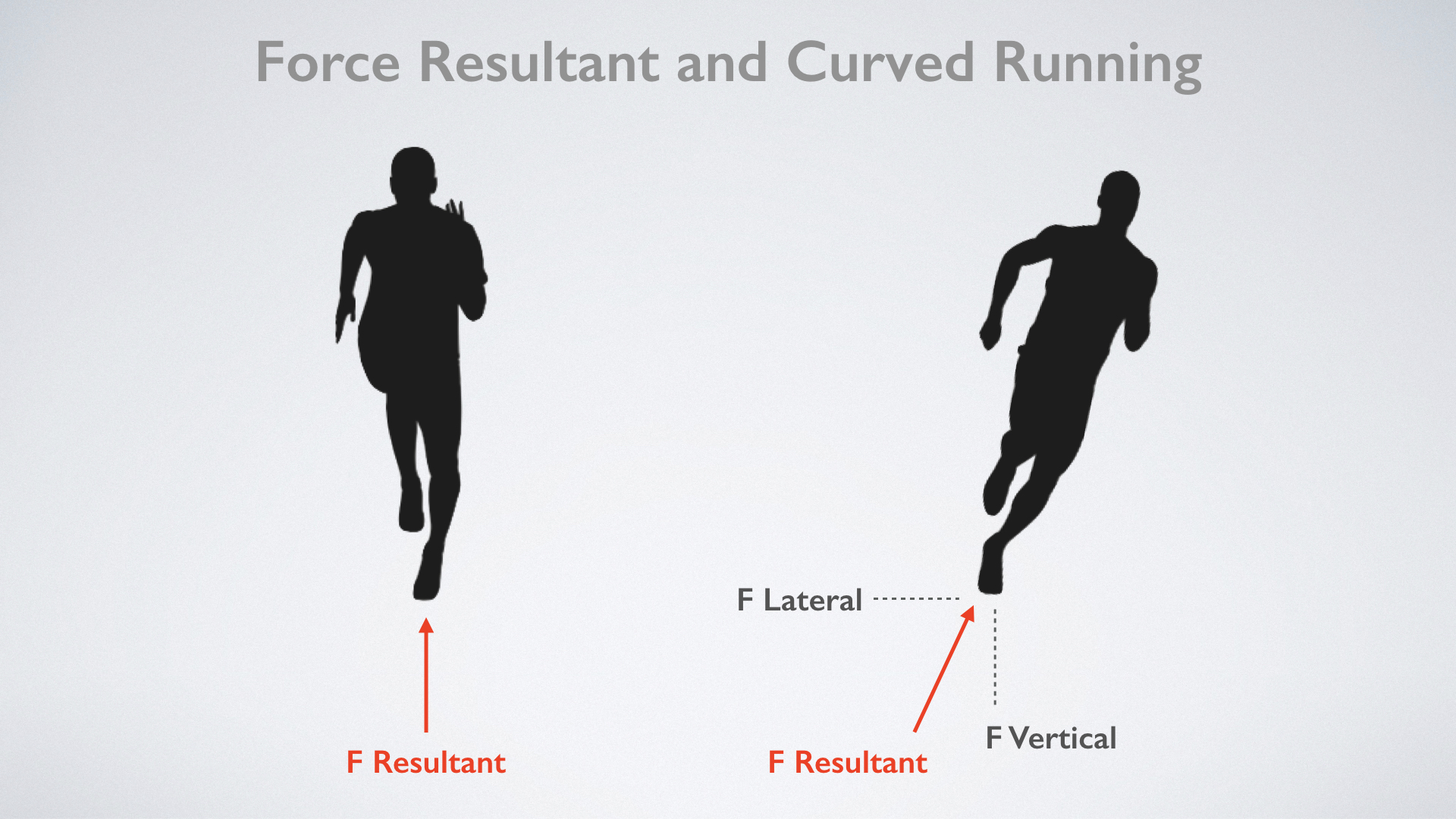[mashshare]
The content found in “The Dosage Debate: Maximum Velocity Sprint Training,” the precursor to this article, was the result of a thought experiment. Besides taking myself through a thinking exercise, one of the goals was to generate dialogue in the coaching community. I have received a substantial amount of feedback and questions since its release, and I feel that explaining my thought process and giving some additional information will help tie up some loose ends and lead to additional dialogue.
First, that article does not really showcase my beliefs one way or another. It is no secret that I am a huge proponent of training that has an athlete attain maximum velocity, but how a coach implements its use within their programming can have quite a bit of variance based on the constraints of their situation. Also, it is important to keep in mind that since I was having the thought experiment with myself, it referred mostly to the clientele I deal with: high school males who participate in track and field. Part of the intent with this article is to broaden the scope to any population.
What ignited the thought experiment was the idea of flipping programming design. In discussion with numerous colleagues, I have found the most common approach is to:
- Create the workout and approximate recovery.
- Administer the workout.
- Adjust recovery as needed.
The approach I took considered recovery on the front end. You can trace most of what follows here back to this quote, posed to me by an anonymous source with credit to Jay Schroeder:
“Only train athletes to a level from which they can recover.”
One way to view this is if I know exactly how an athlete will recover from sprint training, what would be the best way to train the athlete to become a faster sprinter? Here are considerations a coach at any level should think about when programming sprint dosage.
Consideration #1 – The Athlete’s Nervous System
Although a common topic in sprint training is which supplemental exercises to use to train the muscles involved, the reality is any movement starts with the nervous system. Many people consider sprinting to be the most intense human activity, and the corollary to this is it places the greatest demand on the nervous system. I often view sprinting through the lens of the amount of electrical current flowing through a person’s body.
It is hypothesized that children are less able to recruit/use fast-twitch (type II) motor units than adults. This makes sense. My 5-year-old is capable of sprinting every day because there are low levels of current flowing. An elite sprinter would obviously lie on the other end of this spectrum. It is like the shock of one of those old trick slices of gum versus a bolt of lightning. A person can handle the trick slice of gum multiple times a day, every day. Getting struck by lightning may have a person sidelined for a prolonged period of time.
It is not just the ability to produce more power, it also comes down to the efficiency of the pathways that the power can flow through, says @HFJumps. Share on XIn addition, it is not all about the raw power that is produced. When people perform a new skill, it rarely looks fluid. As the person continually undergoes the activity, the body figures out a more efficient way to carry it out. This is the nervous system eliminating the neural pathways that do not assist with the activity and deepening the pathways that allow for the best current solution. So, it is not just the ability to produce more power, it also comes down to the efficiency of the pathways that the power can flow through. Eliminating and solidifying neural pathways takes time, and can only be accomplished when the opportunity is provided, but how often is appropriate?
Consideration #2 – Frequency
I recently spoke with a college strength coach who said he had his pre-teen son sprint every day over the summer, and he continually improved his speed. As Boo Schexnayder stated in his recent article, “The Syndrome”:
“The younger athletes, because of their lower levels of power output, do very little internal damage to their bodies as they practice, train, and compete. They don’t possess the high levels of athleticism needed to hurt themselves. Thus, they require little recovery time.”
If we view this looking at a high school athlete over the course of their four-year career, we would conclude that the density of high-intensity training sessions would decrease as the athlete is able to produce more powerful outputs. I have heard from numerous coaches of elite athletes at the collegiate level and beyond that athletes can only attain maximum outputs in training once a week or less. Schexnayder continues:
“The more developed athletes are victims of the tools they possess. Their high power output levels produce more internal stress and damage. They require more recovery time.”
The following diagrams give a visual representation of these concepts:


Reality does not produce smooth curves, but an overlay of the two graphs gives a good theoretical starting point in designing sprint dosage for all ages. I have a theory that sprinting is the Fountain of Youth. As people age, a common approach to training is to decrease the intensity of activity. While this makes sense on the surface, I also think it is a self-imposed ceiling on one’s capabilities. In other words, if I am always capable of performing what is regarded as the most intense human activity (sprinting), shouldn’t I be capable of adapting to activities that are less intense?

Consideration #3 – The Athlete’s Insulation
When I played youth football, just about everyone played both ways, and no one thought twice about it. By the time high school football came around, however, this was very rare. Our best players may have played a few series on their nondominant side of the ball during a game. (Note: I attended a high school with 2,000 students, so ironman football was not a necessity.)
This pattern is logical. Most high school males are in the heart of puberty, and becoming a man creates the ability to produce more power. However, the body’s ability to recover from the increased power it can produce does not seem to come along for the ride. Therefore, it makes sense for coaches to utilize a two-platoon system.
This takes us to the conversation about an athlete’s “insulation.” In sticking with the electricity analogy, insulators serve as protectors from the dangers of electrical current. My corresponding thought to this is, “Can we enhance the ‘insulators’ in the body so an athlete is better able to recover from the ability to produce higher levels of power?” I believe we can by exposing prepubescent athletes to sprinting on a regular basis.
I have been part of and have observed a large number of sport practices ranging from youth to college. One commonality among them is that the opportunities to produce the highest levels of power possible are few and far between. I played multiple sports from age 4 through 21. My first true speed session was when I was 18.
A large number of sport practices, ranging from youth to college levels, don’t give athletes many opportunities to produce the highest levels of power possible, says @HFJumps. Share on XThanks to the efforts of many coaches and organizations, this is becoming less common, but it still exists. I currently live near a youth soccer field. Most of the practices there involve kids standing around and going through a drill where the power levels are low. I have yet to see them spend any time performing true sprints (giving the athletes time to recover fully so they produce their best output).
A common complaint by numerous groups about today’s youth is their lack of free play and activity. It seems the days of eating breakfast at home, heading out to play with the crew, and returning home when the street lights went on for dinner are long gone. During that time outside of the house, one skill that I developed was the ability to sprint. It is amazing how I can look back at my summers as a youth and see how each day represented multiple sessions of a sprint practice.
A simple game of tag at a park consisted of short bursts of maximum effort followed by recovery. Riding a bike to a friend’s house to play Wiffle ball was recovery. Running the bases and playing the field in Wiffle ball had moments of maximum effort, and the rest of the game allowed for recovery. Lunch, wherever we could get it, was downtime. The football or basketball we played afterward also followed the same pattern. All of these activities provided opportunities to chase and elude, which are excellent drivers of intent. Timing and racing are two more.
I say all this because if our youth are not getting exposed to these types of activities, we have two choices: continue to complain about it or provide them with opportunities to express maximum power. If they are not getting it in their own free time, devoting some time to it in your sport practice seems like an easy fit. Not only will they reap the rewards of developing more effective neural pathways, but their ability to recover from the higher level of power outputs may come along for the ride.
Consideration #4 – Outliers
A trend we have noticed with the freshmen in our program over the past few years is approximately 10% have had nagging hip flexor issues. Our sprint program would be classified as low volume by most, and we design everything around improving acceleration and maximum velocity. By the time they are sophomores, those issues go away, but we would prefer for this trend to not be present. We have two hypotheses that are not mutually exclusive to one another:
- The athletes undergo a tremendous amount of change due to puberty.
- The athletes have not experienced operating at maximum velocity, possibly due to a combination of a sedentary childhood and exposure to sports in which bouts of maximum velocity are few and far between. While incredibly intense, basketball, football, and soccer do not allow exposure to true maximum velocity (as found spiked up on a track) due to factors such as fatigue, equipment, surface, and court dimensions.
Our belief is that it is probably a hybrid of the two. The growth, coupled with their bodies being shocked into operating at an intensity they haven’t dealt with, leads to issues. We feel 10% is too high of a percentage, and we are toying with ideas from Sam Portland (speed gate golf) and Ross Jeffs (racers versus trainers) to help combat this issue.
Consideration #5 – The Load of Curvilinear Sprints
Any track coach whose athletes have performed regular training or competition on a 160-meter indoor track are well aware of the mechanical damage that moving at high velocity on a tight curve can cause. The previous article outlined the advantage of curvilinear sprints as a way to protect the nervous system because they involve the athletes moving at a velocity lower than what is found in linear sprinting. That being said, a coach must be aware of the forces placed on the musculoskeletal system when sprinting on a bend. The resultant force vector changes when an athlete is on a curve because a significant lateral component is required to stay on the curve.

The following equation gives the net force on an object moving in a circle (centripetal force). The force is based on the radius of the curve as well as the mass and velocity of the object.

Although the exact physics involved in running on a curve are quite complicated, we can use this formula to have a fundamental understanding of the impact velocity and radius have on centripetal force.
First, there is a good chance an athlete’s mass won’t change much during the course of a training session, so we will assume it is constant. With mass out of the way, we can focus on velocity. Imagine an athlete jogs on a curve at a velocity of 5 m/s. Then, on the next repetition, the athlete doubles the velocity to 10 m/s. The force required to move twice as fast and continue the motion on the curve would be four times as much because the velocity is squared. The example below shows this comparison, ignoring units for simplicity. The hypothetical mass used was 100, velocity of 5 (left example) and 10 (right example), and radius of 10 (denominator).

The next example shows the impact of the radius on force by leaving the mass (100) and velocity (10) constant in both. We can see that decreasing the radius from 10 to 5 (values in the denominator) causes the force to double.

With these examples in mind, we can use the following assumptions moving forward:
- Force vectors are different on a bend, which places a different demand on the musculoskeletal system (when compared to linear sprinting).
- If an athlete begins to move at a higher velocity on a bend, greater force is present.
- If the radius is tightened, and the athlete is able to move at the same speed, greater force is present.
We can now carry these into training implications:
- Identify the demands of the sport and design curvilinear training accordingly.
- If you introduce curvilinear work, err on the side of caution. Like any form of training, damage can result from an improper dose, but this may be even more true with this modality because it may be foreign to a high percentage of athletes. Stimulate the musculoskeletal system—do not destroy it.
- Do not be afraid to experiment with different radii and speeds. When operating at high speeds with sprinters, use large radii (such as the example provided in the precursor to this article). These types of sprints can help prep athletes for the nasty curves they face during indoor competitions. When operating at lower speeds, such as submaximal curve runs with high jumpers, you can tighten the radii.
- Trust your eyes! If the athletes look fluid, your setup is probably safe. If they don’t, you may need to make adjustments. Being able to make this determination requires you to watch your athlete’s reps!
- Even if a track athlete is only a sagittal specialist (short sprints/hurdles, long jump, triple jump), bend work still carries weight as a valuable tool in developing a robust athlete because of the variation in the force vectors placed on the body. Field and court sport coaches should also thank you for your efforts of having them spend some time outside of the sagittal plane.
- An additional force we should consider besides centripetal force is one we should never forget because it always wins: the force of gravity. According to Mike Kennedy, accomplished physics teacher and track/cross country coach at Neuqua Valley High School, “If you assume gravity acts at the runner’s belly button, the torque from the ground force and the force of gravity will put a great deal of stress on the hip, leading to injury if the athlete is not prepared for such stresses. It is essentially a class 1 lever with the hip as the fulcrum.” Athletes can perform simple serpentine runs with large radii at various speeds on a track, court, field, or hallway during a warm-up or cooldown or in the heart of the workout.
Where Does This Leave Us?
On one hand, I think designing sprint training is simple. Tony Holler and I co-authored an article that was prompted by his tweet: “Speed training is really pretty simple. Why is there so much confusion?” If we are patient and willing to accept small gains, programming can be basic at the novice level, and the baseline will rise for all. It is hard to go wrong with having an athlete sprint 2–3 times per week if the dose is appropriate and the recovery is sufficient.
If we are patient and willing to accept small gains, programming at the novice level can be basic, and the baseline will rise for all. However, we will miss what is optimal for some. Share on XOn the other hand, as a coach who has worked with groups of up to 60, I know I am missing what would be optimal for some. Trying to address their individual needs makes designing and managing sprint training quite complicated.
As a teacher, one of my primary goals is to get people to think, so I will leave you with four thoughts to ponder in regard to sprint dosage:
- When do your athletes need to be recovered from a sprint dose?
- How long do you think it will take your athletes to recover from your prescribed dose?
- Do you have contingency plans in place?
- If you had to sprint every single day or die, how would you adapt?
Special thanks to Jake Cohen of the University of Illinois for providing feedback on the original article, which helped create this. Also thanks to Mike Kennedy of Neuqua Valley High School for his review and input for this article.
Since you’re here…
…we have a small favor to ask. More people are reading SimpliFaster than ever, and each week we bring you compelling content from coaches, sport scientists, and physiotherapists who are devoted to building better athletes. Please take a moment to share the articles on social media, engage the authors with questions and comments below, and link to articles when appropriate if you have a blog or participate on forums of related topics. — SF
[mashshare]





